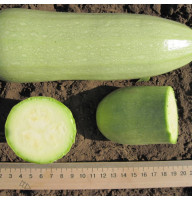Zucchini is a problem-free vegetable crop that produces huge yields even for novice gardeners. But how to preserve zucchini for the winter, when you no longer have the strength to preserve it, and the multi-colored “woodpile” doesn’t even think about ending?
In order to delight your family with culinary delights based on this healthy vegetable all winter, you don’t have to dig your own cellar or become a regular at the nearest vegetable shop. You can store zucchini at home both in an apartment and in a private house. To do this, you just need to choose special varieties and properly prepare vegetables for wintering.
The best varieties of zucchini for winter storage

Not all varieties of zucchini can be preserved in winter; most should be eaten immediately after harvest. However, there are also those that are suitable for long-term storage. Vegetables of these varieties have common characteristics: thick skin, small seeds, dryish pulp. Thanks to this, they are stored for a long time and tolerate transportation well.
If you want to keep zucchini fresh for as long as possible, plant varieties and hybrids such as Aeronaut, Arlika, Aral F1, Negro, Anchor and others marked “excellent keeping quality” on the packaging.
Zucchini for winter storage must be cut from the bush, preventing it from overripening. The length of the stalk must be at least 5 cm - this will protect the fruit from the penetration of pathogens into the pulp. It is recommended to carefully shake the collected zucchini off the ground, but washing or soaking them is strictly prohibited.
How to store zucchini in winter

There are no strict requirements for what temperature to store zucchini at. Of course, the optimal temperature will be 4-10°C and humidity about 80%. Such conditions can be achieved in a cellar or underground, but not all summer residents have them. If your house is not equipped with a vegetable storage facility or you cannot get to the village in winter, you can store zucchini in other ways.
How to store zucchini in the basement
For those who have a frost-free basement or subfloor in their house, garage or country house, organizing the storage of zucchini for the winter is simple. It is enough to place a separate wooden shelf for these vegetables, covered with a thin (10 cm) layer of straw and arrange the fruits so that they do not touch each other.
If there are no shelves, then wooden or plastic boxes stacked on top of each other can be used for storage. Be sure to hang a thermometer on the wall and remember to regularly ventilate the room to reduce the likelihood of mold and rot on vegetables.
Don't know how to store fresh zucchini while trying to save space? Ordinary nylon tights will come to your aid. Place the zucchini one at a time and hang the resulting “garland” directly from the ceiling - this way they can be stored for up to 3 months.
How to store zucchini in an apartment

You can also store zucchini in your apartment in winter, although in this case they will not last until spring. The optimal place for vegetables would be a special box located next to the balcony or front door, a pantry or an insulated balcony. As a last resort, you can put the zucchini under the bed, but you will need to check it more often than usual.
When storing zucchini in boxes or on shelves, place cardboard dividers, straw, or carefully wrap each in paper between them. This will extend the shelf life and prevent diseases from spreading throughout your entire stock at once.
How to store zucchini in the refrigerator

Not sure if you can store zucchini in the refrigerator? You can if you don’t have many of them and the vegetable tray can accommodate them. True, each vegetable will have to be placed in a separate paper bag with several holes for ventilation and less frequently transferred from place to place.
Although no one will give you a definite answer to the question of how long zucchini can be stored, it is worth remembering that after 3-4 months the skin of the vegetables will become very hard, the seeds will begin to sprout, and the pulp will acquire a bitter taste, so it is better to eat even visually preserved fruits no later than this period.
The skin on lying zucchini becomes hard and is difficult to peel off with a regular knife. To solve this problem, soak the squash in warm water for 30 minutes before peeling.
What to do if zucchini starts to spoil
In order to avoid crop loss, as well as the spread of fruit flies throughout your apartment, regularly check the condition of your vegetable supplies. If you find that one or more zucchini has begun to leak, mold, or dry out, you need to immediately remove them from the rest and then put them to work.
Throw away moldy vegetables immediately - mold spores are insidious, and in a zucchini that is 90% water, they spread with incredible speed. You should not eat such a vegetable even after heat treatment.
If the zucchini is a little dented or has begun to dry out, quickly prepare food from it, but, again, do not eat it fresh, but fry it, stew it, or add it to soup, having previously cut out all the damaged areas.
We hope the methods listed will help you preserve fresh zucchini at home, and you will be able to enjoy delicious and healthy dishes all winter.










